Control of information in Chicago reaches laughable Orwellian levels... Swelling 'Phalanx of Flacks' shields Brizard from reporters' questions
When Chicago Public Schools "Chief Executive Officer" Jean-Claude Brizard once again went outside Chicago (at some cost for "relocation expenses," as yet unknown) to pick two replacement executives for two women his administration had driven out in less than one year (in one case), the news was distributed in such a way that the CEO didn't have to answer any direct questions from reporters — even the most corporate friendly sycophants among them. It was April 2012, and Noemi Donoso and Barbara Bowman were following Andrea Saenz and Jamiko Rose out the door at 125 S. Clark St., the headquarters of the third larges school system in the USA. Of those four top officials, only Bowman had been at CPS when Rahm Emanuel became mayor in 2012 and selected Jean-Claude Brizard to be the CEO of CPS.
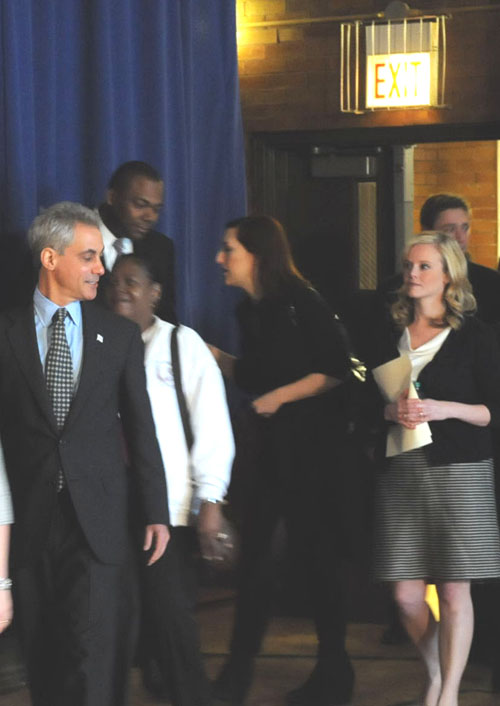 Chicago Mayor Rahm Emanuel and Chicago schools Chief Executive Officer Jean-Claude Brizard are show above arriving at the media event they staged at Chicago's "Disney II" elementary school on April 10, 2012, to announce that the longest school day that Emanuel and Brizard had promoted for the previous year would be less long than they had previously insisted was necessary. Brizard (second from left) is being briefed by Chicago Public Schools "Chief Officer for Communications" Becky Carroll (leaning towards Brizard) in the above photograph. Carroll, who came to CPS from outside, was awarded an annual salary of $165,000 when she was appointed on June 22, 2011 on the recommendation of Brizard and with the approval of the Board of Education (which had just been appointed by Emanuel). Within one year, Carroll has nearly doubled the number of people working on public relations on the sixth floor at CPS, while decreasing the amount of time reporters get to actually question Brizard and other administration officials. Substance photo by George N. Schmidt.But the late April announcement that Barbara Byrd Bennett (currently of Detroit) and Beth Mascitti-Miller (currently of Rochester) would be replacing Noemi Donoso and Barbara Bowman was done by email, as usual. That meant, as usual, that Brizard once again got away with mak-ing a major decision regarding the future of Chicago's more than 400,000 public school children (including two of my own) without reporters having the chance to ask Brizar any questions at an open press conference. Among those ques-tions would be why, of his last 20 appointments to top exec-utive positions in CPS, not one of them has any experience, knowledge, or credentials to teach or do administrative work in Chicago or Illinois.
Chicago Mayor Rahm Emanuel and Chicago schools Chief Executive Officer Jean-Claude Brizard are show above arriving at the media event they staged at Chicago's "Disney II" elementary school on April 10, 2012, to announce that the longest school day that Emanuel and Brizard had promoted for the previous year would be less long than they had previously insisted was necessary. Brizard (second from left) is being briefed by Chicago Public Schools "Chief Officer for Communications" Becky Carroll (leaning towards Brizard) in the above photograph. Carroll, who came to CPS from outside, was awarded an annual salary of $165,000 when she was appointed on June 22, 2011 on the recommendation of Brizard and with the approval of the Board of Education (which had just been appointed by Emanuel). Within one year, Carroll has nearly doubled the number of people working on public relations on the sixth floor at CPS, while decreasing the amount of time reporters get to actually question Brizard and other administration officials. Substance photo by George N. Schmidt.But the late April announcement that Barbara Byrd Bennett (currently of Detroit) and Beth Mascitti-Miller (currently of Rochester) would be replacing Noemi Donoso and Barbara Bowman was done by email, as usual. That meant, as usual, that Brizard once again got away with mak-ing a major decision regarding the future of Chicago's more than 400,000 public school children (including two of my own) without reporters having the chance to ask Brizar any questions at an open press conference. Among those ques-tions would be why, of his last 20 appointments to top exec-utive positions in CPS, not one of them has any experience, knowledge, or credentials to teach or do administrative work in Chicago or Illinois.
And it continues to be unlikely that Brizard will ever face such questions as the Brizard admnistration, while claiming it is facing an unprecedented "deficit," continues to pay "relocation expenses" to out-of-towners who are imported for Chicago schools work, and simultaneously continues to ex-pand its "Communications Department" to the most expen-sive and highest number of people in the history of Chicago's Public Schools.
Thus, this article has two parts. The first part will examine the slow accretion of overpaid and underqualified outsiders who are now holding the top ranks at CPS. This part will also examine how, over time, the public would become more and more aware of the outlines and ideology behind what amounted to an undisclosed plan to radically reshape the public schools of the third largest school system in the USA with virtually no democratic public input or debate.
The second part will discuss one iteration of that phenomenon: The unprecedented expansion, in both personnel and cost, of the publicity department at the nation's third largest school system. To put a start point on what is now a bloated "Communications" staff at CPS: when mayoral control began in 1995 at CPS, there was one person, former Sun-Times education reporter Maribeth Vander Weele, handling all information requests and publicity for the school system.
Even as late as the Ron Huberman years, there were never more than a dozen people working in the Board's communications office. Today, there are 19 positions in the "Office of Communications," and requests for even the most basic information under the Illinois Freedom of Information Act (FOIA) are routinely stalled or denied, with the FOIA officer not on the Sixth Floor (where "Communications" and the Of-fice of the Board are housed) but on the Seventh Floor (in the Law Department).
The combination of the two phenomena is typical of the totalitarian regimes of the previous century, and has all the earmarks of them now that the first year of the Reign of Rahm is ending. Another feature of that year, despite the accolades from some other media, is the destruction of what is commonly known as "transparency." Like other totalitarians before him, Chicago's mayor says the opposite of what he is doing. Information about the basic workings of CPS is now being hidden from the public in ways like never before, and when certain information is forced out of the regime, it is of-ten provided in ways that are nothing like either the letter or spirit of the laws.
 Brizard is rarely allowed to answer questions from reporters except under the watchful eye of Mayor Rahm Emanuel and the virtual army of media handlers from both City Hall and CPS. Above, Brizard puzzles over a question during the brief April 10, 2012 press conference at Disney II Magnet School. The media event was staged to announce the Emanuel had ordered Brizard to lower the required number of hours for elementary schools from 7.5 per day to 7.0 per day, following protests across the city from parents, teachers, and community activists. Substance photo by George N. Schmidt.In April 2011, Mayor Rahm Emanuel announced that he had selected the controversial superintendent of the Rochester New York public schools system, Jean-Claude Brizard, to become the new "Chief Executive Officer" for Chicago's public schools. On June 22, 2011, Board of Educa-tion approved the appointment of Brizard by a unanimous vote, without discussion or debate. Brizard's annual salary was established at $250,000 — the highest in history. The Board also voted to award Brizard "relocation and transition expenses" totaling $30,000 in the same vote. Brizard simultaneously became the highest paid chief in the history of the nation's third largest school system and the first to be paid "relocation and transition expenses." Brizard's contract also includes a possible bonus for "performance" (which has not been disclosed to the public).
Brizard is rarely allowed to answer questions from reporters except under the watchful eye of Mayor Rahm Emanuel and the virtual army of media handlers from both City Hall and CPS. Above, Brizard puzzles over a question during the brief April 10, 2012 press conference at Disney II Magnet School. The media event was staged to announce the Emanuel had ordered Brizard to lower the required number of hours for elementary schools from 7.5 per day to 7.0 per day, following protests across the city from parents, teachers, and community activists. Substance photo by George N. Schmidt.In April 2011, Mayor Rahm Emanuel announced that he had selected the controversial superintendent of the Rochester New York public schools system, Jean-Claude Brizard, to become the new "Chief Executive Officer" for Chicago's public schools. On June 22, 2011, Board of Educa-tion approved the appointment of Brizard by a unanimous vote, without discussion or debate. Brizard's annual salary was established at $250,000 — the highest in history. The Board also voted to award Brizard "relocation and transition expenses" totaling $30,000 in the same vote. Brizard simultaneously became the highest paid chief in the history of the nation's third largest school system and the first to be paid "relocation and transition expenses." Brizard's contract also includes a possible bonus for "performance" (which has not been disclosed to the public).
On June 22, 2011, Board of Education also approved the appointment of Noemi Donoso, from Colorado, by a unanimous vote, without discussion or debate, to the position of "Chief Education Officer." Donoso's annual salary was established at $195,000, and she was also granted $21,000 for "relocation and transition expenses..." Donoso's contract supposedly extended until July 1, 2013, but she was out by the time of the April 23, 2012 Board of Education meeting. The Board has not announced whether it is paying Donoso a severance because she was reportedly forced out of her job.
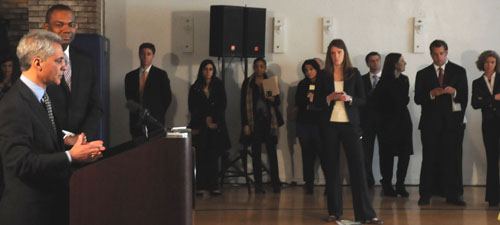 At most of the media events staged carefully by Mayor Rahm Emanuel and Schools CEO Jean Claude Brizard, the number of mayoral aides and CPS and City Hall press flacks outnumbers the number of actual independent reporters. Above, in the background, is seen part of the City Hall and CPS media team including mayoral education liaison Beth Swanson (far right) and CPS Communications chief Becky Carroll (third from right). Substance photo by George N. Schmidt.On June 22, 2011, Board of Education also approved the appointment of Andrea Saenz by a unanimous vote, without discussion or debate, to the position of "Chief of Staff to the Chief Executive Officer." Seanz's annual salary was established at $165,000, and she was also granted $7,500 for "relocation and transition expenses..." No one on the Board, then or since, has asked publicly why it cost more ($30,000) to move Brizard than it cost to move Donoso ($21,000) or Sanez ($7,500). The Board members were supposedly appointed because of their business acumen. Their unwillingness to monitor such expenses became evident from the beginning.
At most of the media events staged carefully by Mayor Rahm Emanuel and Schools CEO Jean Claude Brizard, the number of mayoral aides and CPS and City Hall press flacks outnumbers the number of actual independent reporters. Above, in the background, is seen part of the City Hall and CPS media team including mayoral education liaison Beth Swanson (far right) and CPS Communications chief Becky Carroll (third from right). Substance photo by George N. Schmidt.On June 22, 2011, Board of Education also approved the appointment of Andrea Saenz by a unanimous vote, without discussion or debate, to the position of "Chief of Staff to the Chief Executive Officer." Seanz's annual salary was established at $165,000, and she was also granted $7,500 for "relocation and transition expenses..." No one on the Board, then or since, has asked publicly why it cost more ($30,000) to move Brizard than it cost to move Donoso ($21,000) or Sanez ($7,500). The Board members were supposedly appointed because of their business acumen. Their unwillingness to monitor such expenses became evident from the beginning.
The hiring of outsiders continued at the July 27, 2011 meeting of the Board. Again, all of the actions took place without discussion or debate.
On July 27, 2011, Board of Education approved the appointment of Ginger Ostro by a unanimous vote, without discus-sion or debate, to the position of "Budget and Grants Man-agement Officer." Ostro's annual salary was established at $167,000. Although Ostro came from outside CPS, she became one of the first major executive hirings by Brizard who did not get a "relocation and transition" bonus. Ostro's hiring was one of the first signed by Tim Cawley as "Chief Admin-istrative Officer."
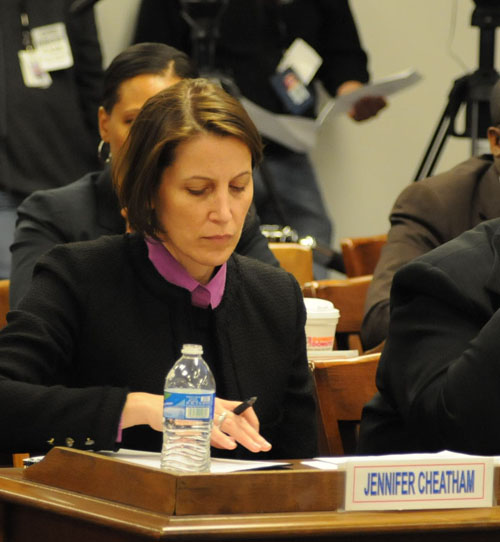 When the Board of Education at its July 2011 meeting changed the job title of Jennifer Cheatham (above, at the January 25, 2012 meeting of the Chicago Board of Education) from "Chief Area Officer" to "Chief Instruction Officer," no one asked why CPS needed both a "Chief Education Officer" (Noemi Donoso, who had been hired by a Board vote at the June 2011 meeting) and a "Chief Instruction Officer." The Board also approved a sort of hiring bonus of $10,000 for Cheatham, even though she had already been working for CPS. Substance photo by George N. Schmidt.On July 27, 2011, Board of Education also approved the appointment of Jennifer Cheatham to the position of "Chief Instruction Officer." No one on the Board asked why CPS needed to have "A Chief Instruction Officer" (Cheatham was to be paid $175,000 per year) and a "Chief Educatoin Officer" (a month earlier, as readers will recall, CPS had hired Noemi Donoso to be "Chief Education Officer" at $195,000 per year. Although Cheatham had been in Chicago as an administrator for a couple of years, she had never taught in Chicago, having been brought in from California under former CEO Ron Huberman. One of the most unusual things about the transfer of Cheatham from the position of "Chief Area Officer" to "Chief Instruction Officer" was that the Board also agreed to pay her what appears to have been a signing bonus of $10,000 — even though she was already working for CPS. The Board Report making Cheatham the "Chief Instruction Officer" stated "The Chief Instruction Officer is provided with a retention payment of $10,000..." Like the others, it was approved without discussion or debate.
When the Board of Education at its July 2011 meeting changed the job title of Jennifer Cheatham (above, at the January 25, 2012 meeting of the Chicago Board of Education) from "Chief Area Officer" to "Chief Instruction Officer," no one asked why CPS needed both a "Chief Education Officer" (Noemi Donoso, who had been hired by a Board vote at the June 2011 meeting) and a "Chief Instruction Officer." The Board also approved a sort of hiring bonus of $10,000 for Cheatham, even though she had already been working for CPS. Substance photo by George N. Schmidt.On July 27, 2011, Board of Education also approved the appointment of Jennifer Cheatham to the position of "Chief Instruction Officer." No one on the Board asked why CPS needed to have "A Chief Instruction Officer" (Cheatham was to be paid $175,000 per year) and a "Chief Educatoin Officer" (a month earlier, as readers will recall, CPS had hired Noemi Donoso to be "Chief Education Officer" at $195,000 per year. Although Cheatham had been in Chicago as an administrator for a couple of years, she had never taught in Chicago, having been brought in from California under former CEO Ron Huberman. One of the most unusual things about the transfer of Cheatham from the position of "Chief Area Officer" to "Chief Instruction Officer" was that the Board also agreed to pay her what appears to have been a signing bonus of $10,000 — even though she was already working for CPS. The Board Report making Cheatham the "Chief Instruction Officer" stated "The Chief Instruction Officer is provided with a retention payment of $10,000..." Like the others, it was approved without discussion or debate.
But there was more than simple bureaucratic expansion taking place during the summer of 2011 as the Rahm Emanuel Board of Education began forging its apparatus.
On July 27, 2011, for the first time in history, the Board, without discussion or debate, approved the expenditure of more than $1 million for outside lawyers. It was unprecedented. Despite the fact that the Board had one of the largest Law Departments in government in Illinois, the Board was paying outside lawyers to do an enormous amount of work, in the public tab. Not one member of the Board of Education, then or in the months afterward, ever questioned this double taxation of the taxpayers. Between July 2011 and the first anniversary of the Emanuel Board's appointment in May 2012, the size of both the Law Department and the bill for outside lawyers would increase at an unprecedented rate. But much of this is the subject of another report being prepared for Substance, and will be highlighted later.
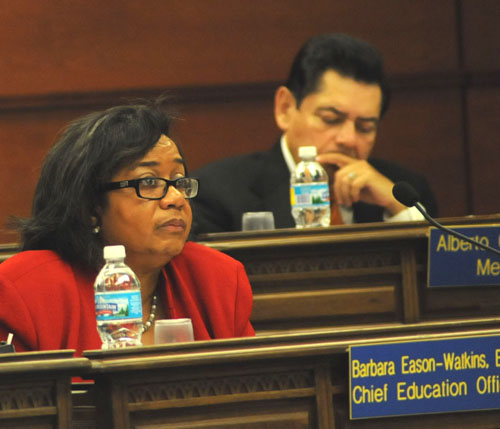 By the April 28, 2010 meeting of the Chicago Board of Education, Chief Education Officer Barbara Eason-Watkins (above) had been isolated by Chief Executive Officer Ron Huberman. Huberman, a police officer whose claims to have mastered something called "performance management" caught the eye of then Mayor Richard M. Daley, came to CPS with even less experience with the city's vast public school system than his predecessor, Arne Duncan (who had been appointed U.S. Secretary of Education by Barack Obama in January 2009). Instead of relying on educators, teachers, and principals (Eason-Watkins had taught in Detroit and been a CPS principal before being appointed Chief Education Officer by Duncan in 2001), Huberman brought in a team of "performance management" people who had worked previously for him at the Chicago Transit Authority, reorganizing bus and subway routes. By the time the above photograph was taken, Eason-Watkins was one month from her departure from the CPS leadership. Huberman didn't even bother to replace her. Substance photo by George N. Schmidt.By the time the Chicago Board of Education met for its monthly meeting on August 24, 2011, it had already estab-lished an expensive series of policies. These included the hir-ing of outsiders with no knowledge or Chicago's schools (and no experience or certification in teaching or administration in Illinois or Chicago), often with relocation expenses attached to the hirings. Since "Personnel" matters are exempt from the Illinois Open Meetings Act, the Board agenda for each of the meetings would not include the hirings of these people (often at jobs that had never existed before), and few reporters do any reading in the CPS "Agendas of Action" which come out after the Board meetings and are available on line (at www.cps.edu) and at the Board's offices at 125 S. Clark St.
By the April 28, 2010 meeting of the Chicago Board of Education, Chief Education Officer Barbara Eason-Watkins (above) had been isolated by Chief Executive Officer Ron Huberman. Huberman, a police officer whose claims to have mastered something called "performance management" caught the eye of then Mayor Richard M. Daley, came to CPS with even less experience with the city's vast public school system than his predecessor, Arne Duncan (who had been appointed U.S. Secretary of Education by Barack Obama in January 2009). Instead of relying on educators, teachers, and principals (Eason-Watkins had taught in Detroit and been a CPS principal before being appointed Chief Education Officer by Duncan in 2001), Huberman brought in a team of "performance management" people who had worked previously for him at the Chicago Transit Authority, reorganizing bus and subway routes. By the time the above photograph was taken, Eason-Watkins was one month from her departure from the CPS leadership. Huberman didn't even bother to replace her. Substance photo by George N. Schmidt.By the time the Chicago Board of Education met for its monthly meeting on August 24, 2011, it had already estab-lished an expensive series of policies. These included the hir-ing of outsiders with no knowledge or Chicago's schools (and no experience or certification in teaching or administration in Illinois or Chicago), often with relocation expenses attached to the hirings. Since "Personnel" matters are exempt from the Illinois Open Meetings Act, the Board agenda for each of the meetings would not include the hirings of these people (often at jobs that had never existed before), and few reporters do any reading in the CPS "Agendas of Action" which come out after the Board meetings and are available on line (at www.cps.edu) and at the Board's offices at 125 S. Clark St.
A major change in CPS organization that had not been re-ported to the public or discussed in public was basically in-stituted at the August 23, 2011 Board meeting when the Board approved the appointment of 13 "Chiefs of Schools" to replace the former "Chief Area Officers." Prior to mayoral control (which began in 1995), Chicago had had subdistricts, each of which was supervised by a "District Superintendent." Like all other administrators, the district superintendents had to have an Illinois Type 75 administrative certificate. Under Paul Vallas, who served as CEO of the city's schools from July 1995 through June 2001, the dub-districts became "Regions" and the top administrators in the "Regions" were named "Region Education Officers" (or "REOs"). The REOs were still certified administrators during the Vallas years.
When Arne Duncan became Chief Executive Officer in July 2001, Barbara Eason Watkins was serving as Chief Education Officer, the second highest paid executive in CPS. Eason-Watkins reorganized the "Regions" into "Areas," and each "Area" was assigned what was called an AIO (for "Area In-structional Officer"). Like all of their predecessors, the AIOs had to be certified Illinois school administrators holding Type 75 certificates. 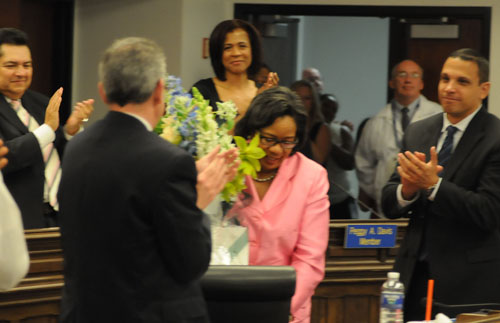 Barbara Eason-Watkins was given an emotional sendoff at the May 2010 Board of Education meeting, with speeches about how much she had done for the schools and the children during her nearly ten years as Chief Education Officer. But the members of the Board of Education (two of whom can be seen in the background above) and CEO Ron Huberman didn't even bother to replace her. Huberman, firmly in power based on his special relationship with then mayor Richard M. Daley, didn't realize that he had less than seven months left in the job himself. When Daley announced that he would not run for re-election in 2001, Huberman, who had pledged over and over that his love for the children of Chicago's public schools transcended all else, abruptly resigned, leaving the school system perplexed through the end of 2010. Substance photo by George N. Schmidt.The next revolution and deregulation of governance in CPS took place when Arne Duncan was appointed U.S. Secretary of Education by President Barack Obama in January 2009, and Mayor Richard M. Daley appointed a protege, Ron Huberman, to succeed Duncan. Without public discussion, Hu-berman deregulated the area officer jobs, changing the name from "Chief Area Officers" (AIOs) to "Area Instructional Of-ficers" (CAOs). The CAOs, for the first time in history, were a powerful group of sub-district administrators who did not have to have any certification or experience in teaching or administration in Chicago or Illinois.
Barbara Eason-Watkins was given an emotional sendoff at the May 2010 Board of Education meeting, with speeches about how much she had done for the schools and the children during her nearly ten years as Chief Education Officer. But the members of the Board of Education (two of whom can be seen in the background above) and CEO Ron Huberman didn't even bother to replace her. Huberman, firmly in power based on his special relationship with then mayor Richard M. Daley, didn't realize that he had less than seven months left in the job himself. When Daley announced that he would not run for re-election in 2001, Huberman, who had pledged over and over that his love for the children of Chicago's public schools transcended all else, abruptly resigned, leaving the school system perplexed through the end of 2010. Substance photo by George N. Schmidt.The next revolution and deregulation of governance in CPS took place when Arne Duncan was appointed U.S. Secretary of Education by President Barack Obama in January 2009, and Mayor Richard M. Daley appointed a protege, Ron Huberman, to succeed Duncan. Without public discussion, Hu-berman deregulated the area officer jobs, changing the name from "Chief Area Officers" (AIOs) to "Area Instructional Of-ficers" (CAOs). The CAOs, for the first time in history, were a powerful group of sub-district administrators who did not have to have any certification or experience in teaching or administration in Chicago or Illinois.
The controversial CAOs remained in power when Huberman abruptly resigned following the November 2010 an-nouncement by his mentor, Mayor Richard M. Daley, that Daley would not run for re-election. In his place, the Board of Education selected Terry Mazany of the Chicago Community Trust to be "Interim Chief Executive Officer." Mazany selected University of Chicago professor Charles Payne to become the new "Interim Chief Education Officer" (Eason-Watkins had taken her pension after Huberman basically ingored her in all major educational decisions).
Mazany and Payne were ousted by Mayor Rahm Emanuel in May 2011, when the mayor appointed Jean-Claude Brizard as Chief Executive Officer and Noemi Donoso as Chief Education Officer.
The "Areas" remained for only three months. In August 2011, without public discussion, Brizard renamed the "Areas" "Networks" and re-assigned most of the CAOs to become "Chiefs of Schools." On August 24, 2011, the Board appointed 13 former "CAOs" to become "Chiefs of School" at an annual salary of $151,131.43 per person. The former Areas, which had been designated by numbers, were given exotic names, based on someone's version of Chicago geography, like the "Austin-North Lawndale Elementary Network" or the "Fullerton Elementary Network" (although no one in Chicago had ever designated the large areas covered by the "Networks" with names anything like those that are now in the CPS organizational chart.
In addition to the "Networks," Brizard and Mayor Emanuel's Board of Education continued to push novel forms of organ-ization and to bring in outsiders whose job descriptions and qualifications were never reviewed in public. Although the claim had been for more than 15 years that CPS "business models" were the epitome of urban public schools govern-ance, by the end of the summer of 2011, Mayor Emanuel was routinely criticizing the lengthy experiment in mayoral control that had been pioneered in Chicago following the 1995 passage of the "Amendatory Act" by the Illinois General As-sembly.
On August 24, 2011, Board of Education approved the ap-pointment of a person named Steve Gering to the position of "Chief of Leadership Development" at an annual salary of $175,000 per year. Keeping with their precedent, no member on the seven member Chicago Board or Education asked why CPS needed to have "Chief Officer of Leadership De-velopment", and why there hadn't been one before. In addi-tion to his annual salary, Gering, who was coming to Chicago from elsewhere, was to receive another $15,000, a sort of signing bonus. The Board Report (11-0824-EX17) stated: "The Chief of Leadership Development is provided with a retention payment of $7,500 and a relocation stipend of $7,500..."
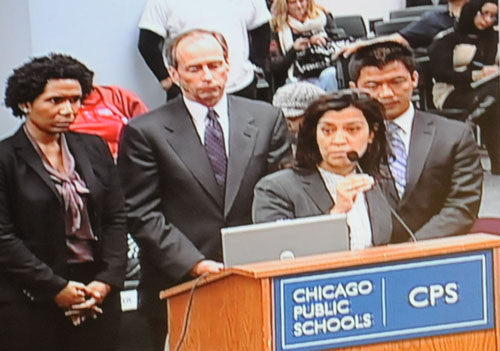 At the February 22, 2012 meeting of the Chicago Board of Education, Chief Education Officer Noemi Donoso explained the Power Point that told the Board members why they were right to turnaround ten schools and close (or co-locate) seven others. Flanking Donoso during her presentation were four members of the leadership team that had been brought in since the previous May (2011) by Mayor Rahm Emanuel and Jean-Claude Brizard, the CEO of CPS. Above, left to right, are "Chief Family and Community Engagement Officer" Jamiko Rose, "Chief Administrative Officer" Tim Cawley, Donoso, and "Chief Portfolio Officer" Oliver Sicat. by May 2012, less than three full months after the above photo was taken of some of the highest paid and supposedly powerful officials in the third largest school system in the USA, Rose and Donoso had been forced out. As of Substance press time (May 5, 2012), the Board of Education has not disclosed how much severance pay Rose and Donoso (and two other top officials who have recently left) had been paid. Substance photo by George N. Schmidt. Also on August 24, 2011, Board of Education ap-proved the appointment of a person named Oliver Sicat to the position of "Chief Portfolio Officer" at an annual salary of $162,500 per year. Keeping with their precedent, no member on the seven member Chicago Board or Education asked why CPS needed to have "Chief Portfolio Officer" or what such a person was supposed to do. Unlike many of the oth-ers being appionted, Sicat, who had not taught in any real Chicago public schools, was already living in Chicago. Since CPS had closed down a west side elementary school three years earlier and converted it to the "Noble Street UIC Cam-pus," Sicat had been a charter school principal in Chicago.
At the February 22, 2012 meeting of the Chicago Board of Education, Chief Education Officer Noemi Donoso explained the Power Point that told the Board members why they were right to turnaround ten schools and close (or co-locate) seven others. Flanking Donoso during her presentation were four members of the leadership team that had been brought in since the previous May (2011) by Mayor Rahm Emanuel and Jean-Claude Brizard, the CEO of CPS. Above, left to right, are "Chief Family and Community Engagement Officer" Jamiko Rose, "Chief Administrative Officer" Tim Cawley, Donoso, and "Chief Portfolio Officer" Oliver Sicat. by May 2012, less than three full months after the above photo was taken of some of the highest paid and supposedly powerful officials in the third largest school system in the USA, Rose and Donoso had been forced out. As of Substance press time (May 5, 2012), the Board of Education has not disclosed how much severance pay Rose and Donoso (and two other top officials who have recently left) had been paid. Substance photo by George N. Schmidt. Also on August 24, 2011, Board of Education ap-proved the appointment of a person named Oliver Sicat to the position of "Chief Portfolio Officer" at an annual salary of $162,500 per year. Keeping with their precedent, no member on the seven member Chicago Board or Education asked why CPS needed to have "Chief Portfolio Officer" or what such a person was supposed to do. Unlike many of the oth-ers being appionted, Sicat, who had not taught in any real Chicago public schools, was already living in Chicago. Since CPS had closed down a west side elementary school three years earlier and converted it to the "Noble Street UIC Cam-pus," Sicat had been a charter school principal in Chicago.
Also on August 24, 2011, Board of Education approved the appointment of a Jamico Rose, a local community organizer with no Chicago teaching experience, to the newly created position of "Chief of Community and Family Engagement" at an annual salary of $152,000 per year. Along with Sicat, Rose's job would become clear within a few months as CPS dispatched her to help engineer and apologize for the largest number of school closings and turnarounds in a decade. Rose and Sicat were in charge of the "hearings" on the pro-posed rules governing closings and turnarounds held in the fall of 2011. Despite widespread community, parent and teacher opposition, the two went along with the Board's ap-proval of the controversial proposals at the Board's Novem-ber 2011 meeting, setting the stage for ten "turnarounds" and seven closings (or "co-locations") in the face of unprecedent-ed community, teacher, and parent opposition during the next four months. By the time the Board voted to rubber stamp the 2012 "Hit List", both Rose's FACE (as "Family and Community Engagement" came to be called) and Sicat's "Portfolio" offices were completely discredited in the eyes of the majority of teachers, parents, and community leaders.
Rose would soon be forced out by Brizard and his narrowing cadre of leaders, while Sicat stays on. (Officially, Rose re-signed prior to the end of her first year in office). Also at the August 24, 2011 Board meeting, the Board added a "Chief of Staff" to its chiefs of staff. By approving "Board Report 11-0824-MO2," the Board appointed Robert Runcie, who had been around CPS for several years since coming to the system from the Broad Foundation, as "Chief of Staff, Of-fice of the Board" at an annual salary of $179,166.67. (Runcie was later to parlay his Chicago experience, which did not in-clude any teaching in Chicago or any Illinois administrative credentials, into the top job in Broward County, Florida). By the end of the summer of 2011, it was unclear how many "chiefs of staff" Chicago Public Schools would have, but it was becoming clear that like all of the other six-figure ad-ministrative posts being created and filled by Brizard and the Board, there would be no discussion allowed on whatever the master plan was. The seven members of the Board never discussed either why the nation's third largest school system needs such offices, , why most of them had to be staffed by people who came from outside Chicago's schools (and very often, from outside Chicago itself) let alone what those in them had to do with the teaching and learning of the more than 400,000 children and young adults attending the city's more than 600 real public schools and charter schools. But within two months of the opening of school, it became clear, through a hailstorm of Power Point presentations by Brizard and the new hirelings at CPS, that there was a plan. The fact that it had been prepared behind closed doors and then rolled out dictatorial style for the Board's seven mem-bers to affirm without real public discussion was not on the agenda, at least within the narrow confines of the central administrators and board members of CPS. And because it was all secret, it took teachers, students, parents, and com-munity leaders some extra time to study the new regime's Master Plan and to try to respond to it.
During the first Board of Education meeting when everyone was back in school, the costly additions to the new bureaucracy continued. September 28, 2011 and October 26, 2011 indicated that the expansion of the new bureaucracy was going to continue without let up, and with no discussion of the financial implication and policy impact of the spending and people involved. It was as if they had all been pre-selected for their jobs and for adherence to some kind of invisible plan shared behind the scenes by Brizard, Mayor Rahm Emanuel, and a handful of un-elected others.
At its September 28, 2011 meeting, the Board of Education expanded its chiefs of staff. By unanimous vote, the Board approved the appointment of an outsider named Todd Connor to the position of "Chief of Staff to the Chief Education Officer" at an annual salary of $145,000. No one asked why CPS was hiring another outsider to a position that paid twice as much as the average teacher and more than most principals.
Also its September 28, 2011 meeting, the Board of Education approved the appointment of an outsider named Akeshia Craven to the newly created position of "Officer for Pathways to College and Career" at an annual salary of $151,131.43. Craven, who was trained as an engineer, had been with CPS for a couple of years, most recently as a CAO. She had no experience in Chicago as either a teacher or principal. At the same meeting, the Board continued to fill the ranks of the newly invented "Chiefs of Schools" by appointing the controversial Kenwood High School Principal Elizabeth Kirby "Chief of Schools for the Southwest High School Network."
The September 28, 2011 meeting also saw the continued expansion of expensive outside lawyers. By a vote of the Board, the law firm of "Neal & Leroy" was approved to receive a half million dollars "to provide legal service in connection with land acquisition and related matter (six) for the Capital Improvement Program..."
Not one of the major expansions of the CPS central and "Network" bureaucracies was on the public agenda that came out from the Office of the Secretary on October 24, 2011, two days before the October 26, 2011 Board meeting. By the time the meeting had ended, however, the Board had approved another $1 million worth of administrative hires, half of them of people who came from outside Chicago and outside education.
At its October 26, 2011 meeting, the Board of Education approved the appointment of Melanie Shaker, who had been working at CPS for two years, to the position of "Deputy Chief Financial Officer and Treasurer" at an annual salary of $170,000.
The Board also at its October 26, 2011 meeting appointed a new Chief Financial Officer, an outsider named David Watkins, at a salary of $195,000 per year. Watkins was also provided with "a stipend for relocation and transition expenses at $15,000..."
Adam Anderson, a new employee, became the "Officer of Portfolio Planning & Strategy" at an annual salary of $135,000 at the same meeting. When they voted to approve the appointment of Anderson, the supposedly business savvy members of the Board didn't bother to ask why CPS needed someone in the newly created "Portfolio" office to do "planning and strategy" (since the new "Chief Portfolio Officer," Oliver Sicat, had only been appointed four months earlier).
The Board itself got its second "Chief of Staff" in six months when it voted to pay Abigayil Joseph (who had been "Officer of Academic Enhancement") to take the position vacated by Robert Runcie, who had been hired to become superintendent of the Broward County Florida schools. Joseph's annual salary, according to the Board Report, was onl $145,000 ($30,000 less than Runcie's).
TO BE FURTHER CONTINUED

